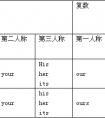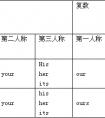句型转换。1. Remember to clean the door.(改为同义句)______ ______ to clean the door.2.I need some help.(改为一般疑问句) ______ you______ ______ help?3.I l-八年级英语
ask for要求。。。
wait for等待。。。
agree with同意。。。
find out(经研究或询问)获知某事
send out 发出,放出,射出
search for 搜索,搜查
chop down 砍到
have.. on 穿着。。。
step out of 跨步走出
drop out of 从。。。掉出
happen to 发生在。。。
belong to属于
arrive in /at到达。。。
try on试穿。。。
vote on对。。。进行投票
strech out伸展。。。
hang out闲逛
leave for离开前往
sell out 卖完、售完
show up 出席;露面
21. run
run after追逐,追捕
run away逃跑
run off跑掉,迅速离开
run out of用完
22. set
set up建立
set off 激起,引起
23. take
take after 与…相像
take off脱掉,起飞
take away拿走
take up从事,占用(时间空间)
take down记录,取下
take back收回
take pride in以… ……为自豪,
take the place of 代替
24. think
think of想起,考虑,对…看法
think out(自然)想出办法
think up想出(设计出、发明、编造)
think about考虑
think over仔细考虑
25. turn
turn off / on打开
turn to翻到,转向,求助
turn down调低,拒绝
turn back返回,转回去
turn round转过身来
turn up向上翻,出现,音量调大
26. care
care about 担心,关心;在乎,介意
care for 关心,关怀,照顾
27. clean
clean up 把…打扫干净,把…收拾整齐
clean out 清除;把…打扫干净
28.learn
learn about 获悉,得知,认识到
learn from 从/向。。。学习
29. fight
fight for..争取获得…
fight against 争取克服、战胜…
fight with…与。。。搏斗/战斗
30. dream
dream of梦想,想橡
dream about 梦到。。。
31. work
work for 为。。工作
work out 产生结果;发展;成功
32. argue
argue with …与。。。争论
argue about..争论。。。
33. complain
complain to 向。。抱怨
complain about抱怨。。。
34. hear
hear of 听说,得知
hear about听到。。。的事,听到。。的话
hear from接到。。。的信
35. talk
talk about 讨论。。。
talk with/to..和。。。讨论
36. live
live in 住在。。。
live on 以。。。为主食
考点名称:一般疑问句
- 一般疑问句:
是疑问句的一种。通常用yes,no来回答的疑问句叫做一般疑问句。口语中若无特殊含义,句末用升调。
其结构是:系动词be/助动词/情态动词+主语+其他成分?
通常回答为:
肯定:Yes+主语+提问的助动词
否定:No+主语+提问的助动词+not
例如:
Are you from Japan? Yes, I am./No, I'm not.
Do you live near your school? Yes, I do./No, I don't.
Can you speak French? Yes, I can./No, I can't. - 一般疑问句的特性:
1.将陈述句变为一般疑问句时,如句中有be 动词(am/ is/ are)时,可直接将它们提至主语前。
如主语为第一人称,应将其改为第二人称。如:
I'm in Class 2Grade 1. →Are you in Class 2Grade 1﹖
We're watching TV. →Are you watching TV﹖
2.陈述句中有情态动词(can、may、must …)时,也可直接将它们提至主语前,即可成为一般疑问句。如:
He can swim now. →Can he swim now﹖
The children may come with us. → May the children come with us﹖
3.陈述句中只有一个实义动词作谓语且其时态为一般现在时,变为一般疑问句时要在句首加do或does主语后的实义动词用原形。如:
I like these animals. →Do you like these animals﹖
She wants to go to the movies. → Does she want to go to the movies﹖
4.一般疑问句一般读升调(↑)
5.一般疑问句有时不用yes或 no 回答。如:
Are they in town now﹖
I think so.
May I sit here﹖
Certainly.
Does he like soccer﹖
Sorry I don't know.
6. 一般疑问句的第一单词总是虚词,读的时候要读轻声。 - 陈述句变为一般疑问句技巧:
根据一般疑问句不同的家族,可以用不同的方法将陈述句变为相应的一般疑问句。
1、第一家族:含be动词或情态动词的句子
秘诀:一调二改三问号
一调:即把句中的be或情态动词调到主语前;
二改:改换主语称谓,即将句中的主语I\my \mines\we\our\ours等。第一人称分别改为相应的第二人称you\your\ yours等;
三问号:句末的句号改为问号。如:
Eg. I am an English teacher. → Are you an English teacher?
Eg. We can speak English fluently. → Can you speak English fluently?
2、第二家族:含行为动词(或称为实义动词)的句子
秘诀:一加二改三问号
一加:即在句首加助动词Do或Does;
二改:1、把谓语动词改为原形;2、改换主语称谓(同第一家组);
三问号:句末的句号改为问号。
Eg. We read English every morning. → Do you read English every morning?
Eg. Tom’s father listens to English on the radio every evening. →Does Tom’s father listen to English on the radio every evening?
特别注意:对于第二家族一定要注意动词的还原,因为时态与数的变化已经体现在助动词上了。
3、加强记忆口诀:
肯变一,并不难,can 或be提在前;
谓语若为行为动,do 或does句首用。
- 最新内容
- 相关内容
- 网友推荐
- 图文推荐
上一篇:_______ late again, Tom.[ ]A. Be notB. Don't beC. Don'tD. Can't-八年级英语
下一篇:—Please don’t tell anybody about this, Linda.— .[ ]A. OK, I willB. No , I don’tC. OK, I won’t D. Sorry to hear that-八年级英语
零零教育社区:论坛热帖子
| [家长教育] 孩子为什么会和父母感情疏离? (2019-07-14) |
| [教师分享] 给远方姐姐的一封信 (2018-11-07) |
| [教师分享] 伸缩门 (2018-11-07) |
| [教师分享] 回家乡 (2018-11-07) |
| [教师分享] 是风味也是人间 (2018-11-07) |
| [教师分享] 一句格言的启示 (2018-11-07) |
| [教师分享] 无规矩不成方圆 (2018-11-07) |
| [教师分享] 第十届全国教育名家论坛有感(二) (2018-11-07) |
| [教师分享] 贪玩的小狗 (2018-11-07) |
| [教师分享] 未命名文章 (2018-11-07) |






